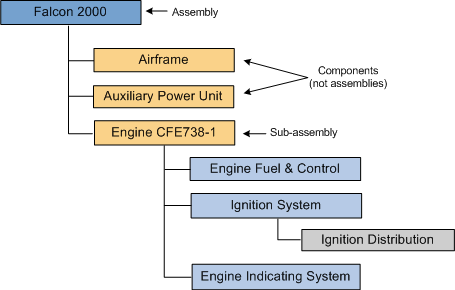Assemblies
An assembly represents a self-contained type of asset that performs a particular function. Examples of an assembly include an aircraft, engine, auxiliary power unit (APU), common hardware (COMHW), and tools and service equipment (TSE).
To model an asset as an assembly, it must possess at least one of the following characteristics:
- The asset has its own maintenance plan, for example, an aircraft.
- The asset accrues usage that must be tracked, for example, an engine.
- The asset is a complex or reusable unit, for example an APU.
An assembly can also be a component of a more complex assembly; referred to as sub-assembly. The top-level assembly is referred to as the parent assembly. For example, an engine assembly can stand on its own, but it can also be a sub-assembly because it plugs into an aircraft assembly, as shown in the following diagram.
Figure: Engine sub-assembly installed on an aircraft assembly
